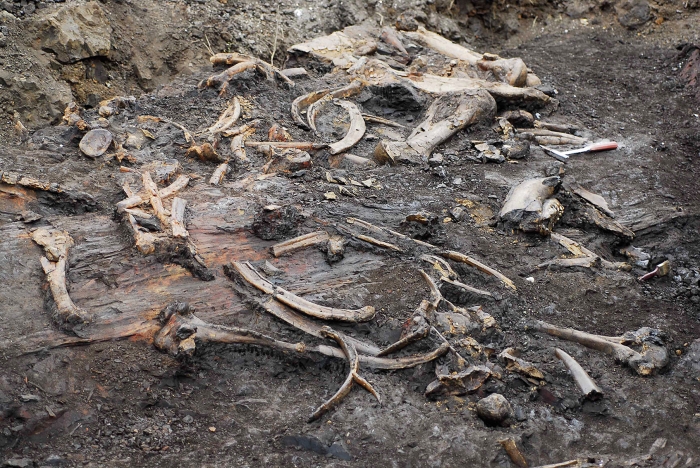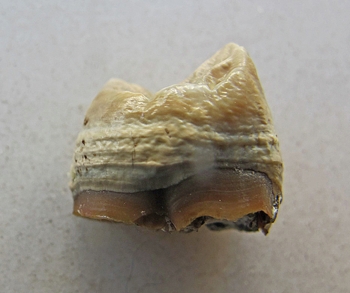New research and prehistoric fossils expose rare window into Earth's environment 6M years ago
A fossil site in southwestern China gives ASU scientists new information about the environment and ecology of the Late Miocene period

Team excavating at Shuitangba in 2009. Photo courtesy Jay Kelley, paleoanthropologist and Institute of Human Origins affiliated researcher.
In Southwestern China in the Yunnan Province, there are lignite mines full of old compressed trees and fossils — a lot of plant and animal fossils from about six million years ago.
Arizona State University paleoecologist Denise Su and a team of scientists started a project in 2007 in the Zhaotong Basin that would last nearly two decades and provide a unique look into past environments.
Scientists believe that reconstructing what Shuitangba was like millions of years ago can help us understand the relationships between climate change and how different species responded and evolved.
While Su’s customary research areas are in Africa, she was interested in the site of Shuitangba because scientists haven’t found many sites outside of Africa that are dated from the Late Miocene period, between five- and eight-million years ago.
“We really wanted to try to understand what was going on during this time frame, and we had so few data points,” said Su, who is a research scientist at the Institute of Human Origins (IHO) and associate professor with the School of Human Evolution and Social Change.
“As it turned out, this was a really interesting site. I think the key takeaway here is that Shuitangba represented a snapshot in time, geologically speaking,” she said.
The wetland environment with trees and standing water produced a lot of clay in between layers of lignite that allowed for amazing preservation of the animal bones, but also presented some challenges.
“It took us time to figure out how to best extract the fossils because this is very wet clay, and it just sticks to the fossils,” Su said. “If you were just to remove the fossil, and clay stuck to the bone at just the wrong area, the surface of the bone would stick onto the clay and once that happens everything just falls apart.”
The animals
After four excavations over the years, the team found 2,400 vertebrate animals, including a new species of apex otter — the size of a wolf — and evidence of the earliest bamboo-eating ancestral panda to have a false thumb. Of the vertebrates found, 60% of the bones were water birds, a very uncommon find at any excavation site.
The team also found three elephant skulls, including a baby. The bones were well preserved and found together on top of a piece of wood. Although the scientists don't know how the elephants died, they know it was simultaneous and fast.
Fig. 3. Excavation of a proboscidean death assemblage at STB. This was likely created by a catastrophic event that killed and quickly buried at least three individuals (two adults and one infant) at or near the water margin; it illustrates a particularly graphic example of the lack of transport at STB that resulted in the recovered faunal assemblage.
The elephants were found during one field season, and after landslides and heavy rain, the team couldn’t locate the remains again even with GPS coordinates. It wasn’t a question of where the remains were but how deeply they were reburied.
Another unexpected find was a baby Lufengpithecus (ape) skull, explained Jay Kelley, paleoanthropologist and IHO affiliated researcher. Kelley has worked at the site since the beginning and said apes were long gone from Europe, South Asia and most of East Asia by this time.
Then there was the unusual recovery of a fossil monkey.
“Throughout nearly all of Eurasia, monkeys only show up after apes become extinct,” said Kelley. “Shuitangba is the first Eurasian site where fossil apes and monkeys have been reliably shown to have coexisted outside of the parts of Southeast Asia where they coexist today.”
“This is a matter of the very late survival of apes in this area, hanging on until monkeys finally entered the region as they rapidly spread after their entry into southern Europe from Africa somewhat earlier in the Miocene,” he said.
The ‘why’
“The past is what shapes the present and the future and that is the foundation that everything is built on,” said Su. “Part of the reason why we are so interested in understanding environments in these critical transition periods is because it gives us a sense of how animals, plants and ecosystems shifted, adapted, changed to respond to those factors.”
By analyzing the sediment, animal remains, and plant remains, this team was able to reconstruct the paleoenvironment at Shuitangba. Fieldwork is complete, however analysis continues on the discoveries.
“It's pretty unusual to have both fossil plants and fossil animals preserved at the same site, and Shuitangba preserves both in abundance,” said Kelley.
“Having both, plus various other kinds of evidence such as data on mineralogy and rock chemical weathering as well as carbon and oxygen isotope records preserved in the teeth of the fossil mammals, allowed us to construct a highly detailed picture of what this part of southern China was like in the latest Miocene,” he said.
The paper, “Paleoecology and paleobiogeography of the latest Miocene site of Shuitangba, Zhaotong,China” was published in the May volume of Palaeogeography, Palaeoclimatology, Palaeoecology.



